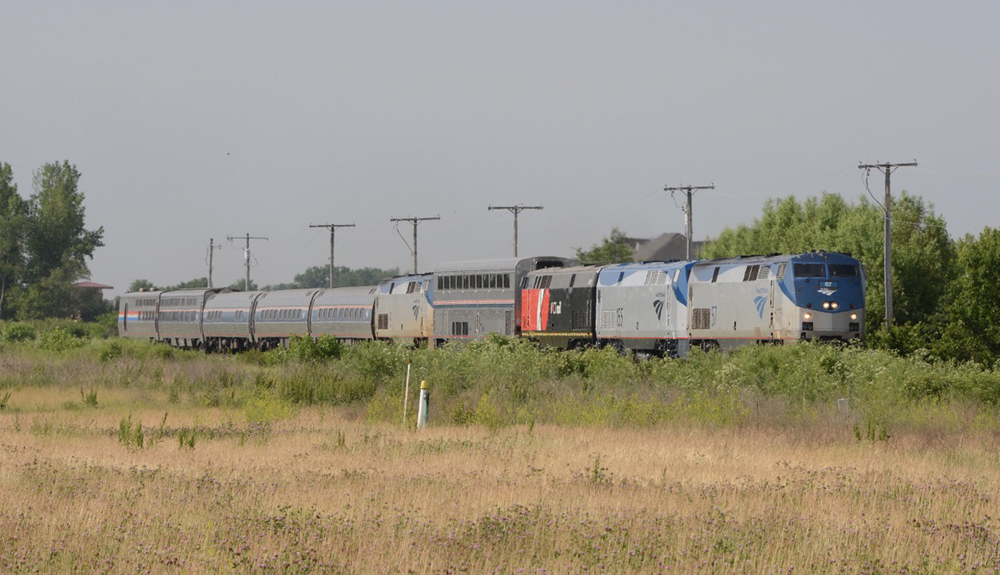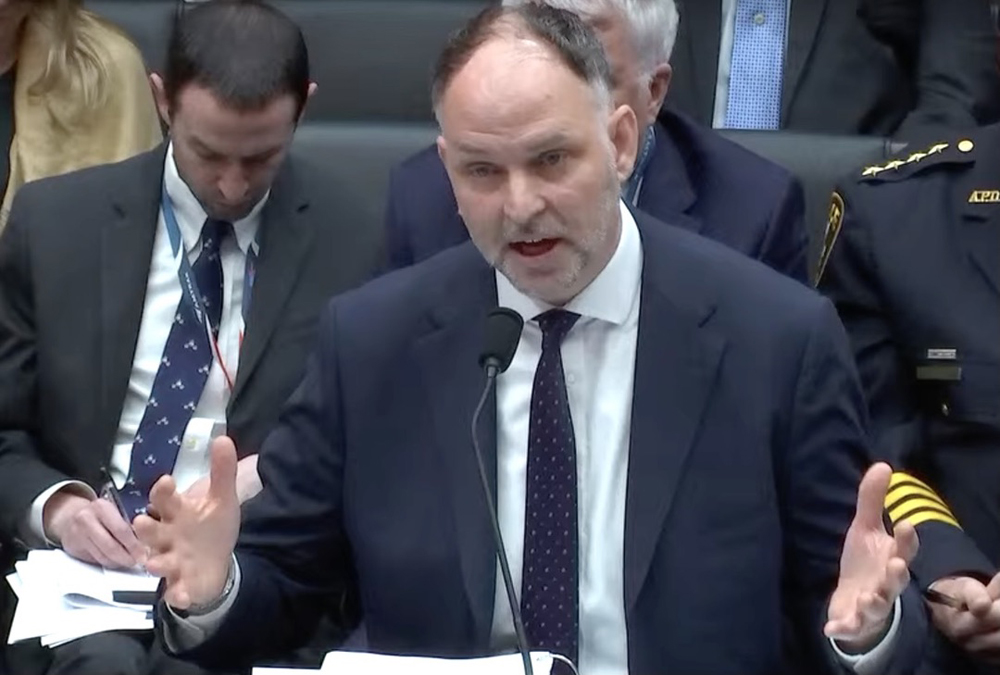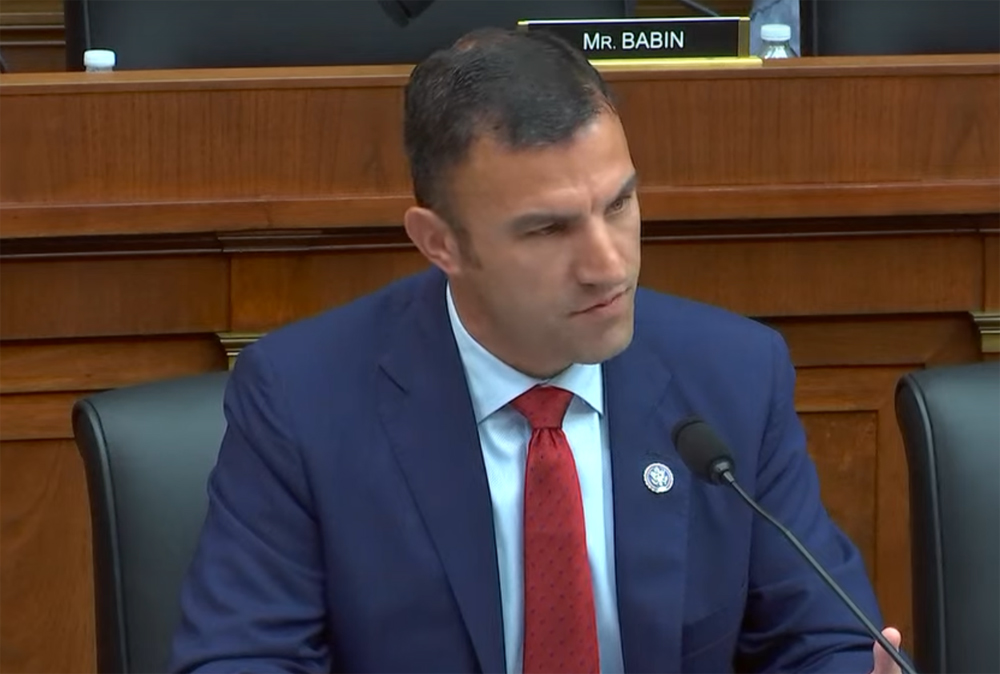
WASHINGTON — Amtrak CEO Stephen Gardner was repeatedly asked to defend his near-$500,000 annual salary, and the company’s practice of giving out six-figure performance bonuses in light of the company’s reliance on more than $1 million in annual taxpayer support during today’s hearing of the House Transportation and Infrastructure Committee.
But there were numerous other takeaways from the nearly 3-hour grilling of Gardner and occasional questions to the other witness, Northeast Corridor Commission executive director Mitch Warren.
Title not reflected by most questioning
The hearing had little to do with its title topic, “Amtrak Operations: Examining the Challenges and Opportunities for Improving Efficiency and Service.” One exception was when Rep. Andre Carson (D-Ind.), representing the Indianapolis area, asked about possible downsizing or outsourcing at Amtrak’s Beech Grove shops. Gardner responded, “Building up the mechanical force is something we have been doing — there is lots of work underway and it is a critical facility for Amtrak…because we’ve got to get our equipment back in shape and keep it maintained.”
Among matters addressed:

— The CEO reiterated that establishing corridor services is up to the states, but “long-distance is really a network we operate on your behalf — It’s a network that Congress and the administration set for us in the [Jobs Act].” When Carson asked about the prospects for a daily Cardinal, Gardner noted Amtrak “had applied for funding to look at daily service on the Cardinal and Sunset Limited. That would allow us to do some preparatory work and the FRA will ultimately decide what the future of the long-distance network could be,” and recommend options for Congress to consider. That funding was part of more than $700 million in grant request for long-distance service announced Monday, along with more than $7 billion in request for the Northeast Corridor [see “Amtrak announces grant applications …,” News Wire, June 5, 2023].
— Gardner hardened the demarcation between its Northeast Corridor operation and the other two business units. He told Rep. Marc Molinaro (R-NY) that the taxpayer subsidy per passenger was about $10 on the Northeast Corridor, $16 for state-supported routes, and about $148 for long distance trains. He did not elaborate that the Northeast Corridor’s relative “operating profit” is possible because most of its costs are capitalized, while the other units’ expenses get allocated against the bottom line according to opaque formulas currently being reviewed by the States for Passenger Rail Coalition.
— Molinaro was one of nine lawmakers who brought up executive bonuses. After quoting a New York Times report that Gardner had received $766,000 in short-term incentive bonuses from 2016 to 2021, Molinaro asked, “What metrics were you measured against to consistently receive from Amtrak, an industry subsidized by taxpayers, without turning a profit?” When Gardner attempted to respond to that question and another about the lack of Americans with Disabilities Act station compliance, Molinaro interrupted the Amtrak CEO six times.
Gardner did claim to Rep. Steve Cohen (D-Tenn.) that the bonus program was adopted in 2015 with the elimination of pensions, “which saved American taxpayers hundreds of millions, a billion dollars in future exposure and traded that for performance-based compensation so that Amtrak’s employees would be tied to the goals and metrics that we set.” The CEO did not, however, elaborate on the goal-setting process.
— Subcommittee Chairman Troy Nehls (R-Texas) showed his unfamiliarity with Amtrak operations and the issues. He suggested only Class II and Class III railroads should be able to apply for Consolidated Rail and Safety Improvement Grants — not Amtrak, since the company was already getting a $22 billion advance appropriation over 5 years. Gardner explained that CRISI grants are designated for specific safety and capital projects, not operations, and almost always have a local match. Nehls, who represents a district southwest of Houston through which the Sunset Limited traverses without stopping, also claimed that Amtrak lacked security because “anybody can buy a ticket without providing ID and give the ticket to someone else.” It’s theoretically possible this can happen with Amtrak e-ticketing and onboard verification ID checks, but not likely.
Questioning Amtrak’s value

— Lawmakers who used questioning to complain about Amtrak’s burden on the U.S. taxpayer appear to place no value on rural mobility. Rep. Rudy Yakym (R-Ind.), who represents the South Bend area, wondered why Amtrak wanted to add a second frequency between Chicago and the Twin Cities when there were 18 nonstop daily flights and driving (nonstop) takes less time. “How is this good business?” he asked rhetorically, discounting the transportation needs of passengers traveling to and from the Empire Builder route’s nine intermediate stops.
— Most Republican criticism regarding profitability came from House members representing districts without Amtrak service, including Missouri’s Eric Burlison (Springfield area), Texas’ Roger Williams (west of Fort Worth), Tennessee’s Tim Burchett (suburban Nashville), and Minnesota’s Pete Stauber (Brainerd and Duluth).
But GOP congressmen who value Amtrak’s presence wanted to make sure their constituents’ needs are met. These include New Jersey’s Thomas Kean, Jr., who wanted more Acela stops at Trenton and Metropark, and western Kansas’ Tracey Mann, who asked Gardner “if you are supportive of long-distance rail routes like the Southwest Chief.” He also heard that Amtrak “was planning on reducing the sleeper car capacity — is this true?”
Gardner said he would “get back to you on the specific details, but our goal here is to, in fact, put as much sleeper capacity as we can on routes with strong demand … the issue is that we have been working through some of the overhauls that have come due and the impact of pieces of equipment we have lost in recent incidents. We have 30 or so wrecked vehicles that can’t be repaired.” He added, “We’re working hard to get more capacity out into all of our long-distance routes because we see success occurring on routes like the Chief.”
A video of today’s hearing is available on the Transportation and Infrastructure Committee site (the 2-hour, 45-minute program starts a half-hour in), along with written statements from Gardner and NEC Commission Executive Director Warren and the opening statement from Rep. Nehls. Statements from Reps. Rick Larsen (D-Wash.) and Howard Payne (D-N.J.) are posted on the committee’s minority-party site.














Amtrak was created to save and serve passengers trains across the whole country. Many trains were eliminated at the creation of Amtrak. It just happened that the busiest part of Amtrak is in the northeast portion of America. That does not mean that that should get all the resources at the cost of long distance trains. Flying or driving should not be our only choices. Trains and busses can provide service to many areas that never could support air service unless it also received a large subsidy from the government. We never seem to question the costs the government spends to improve airports or roads that go through sparsely populated areas. If we studied the costs to build these things I doubt many fixed cost items are covered by taxes or fees paid for by the operators or passengers in these areas.
Representative Mann clearly hasn’t followed Amtrak’s equipment distribution plan this summer. They’ve assigned a generous amount of equipment to the Midwest to West Coast routes like reinstating a second sleeping car on the California Zephyr, adding a third coach and a baggage car to the Southwest Chief, and adding second sleeping car to the Seattle section of the Empire Builder. It’s the single night trains that Amtrak isn’t so generous with assigning equipment like pulling off the recently regained second sleeping car on the Capitol Limited, thereby cutting it to an abysmal three car train and a baggage car!!! It sold out for all of May and is totally sold out for this month too. Just last summer, the train was assigned two sleeping cars and three coaches! The Texas Eagle still remains without a sightseer lounge car and a transition sleeping car, which most of the time results in the lone sleeping car either being sold out or with prices too high to encourage patronage. Amtrak also wouldn’t bolster coach availability enough where they could have the third coach on the Eagle operate all the way from Chicago to San Antonio rather than just to St. Louis. Remember too that in March of last year the Texas Eagle regained a third Chicago to San Antonio coach. But at the end of May, just in time for summer, Amtrak pulled that coach off and gave it to the Southwest Chief! Even the Coast Starlight which used to be the most glamorous train on Amtrak’s entire network, cut down to just two sleeping cars and two coaches down from three sleeping cars, two coaches and a business class car that it operated with last summer, only had a baggage car added for this summer!! Amtrak is choosing to operate it’s two night trains with as much equipment as it can and only leaving enough for the other trains to just have both classes. I’d love for someone to ask Gardner what influenced their decision to operate the Capitol Limited with just three cars and a baggage car for the summer; why the Texas Eagle still doesn’t have a lounge car or a transition car; and why businesses class service has been discontinued from the Coast Starlight and why it has one less sleeping car this summer than last all while demand is approaching pre-pandemic levels if not already back.
A Chicago – St Paul train is good for Amtrak because that state sponsored route counts as “revenue”.
Pretty bad for tax payers though.
After 52 years this whole charade of endless studies, committees, meetings, etc. is getting tiresome. A previous poster took issue with an Indiana congressman questioning the second Twin Cities train. The congressman gets to question the train project because it will be using federal funds. This arrangement is part of the problem with Amtrak. Any congressman or senator of the 535 total can question, criticize or obstruct a given project even far from their home state because of the federal funds being used.
By the way, the congressman’s question seems to indicate a lack of knowledge of some basic business economic principles, i.e. economies of scale, maximizing use of a set of fixed costs, increased total demand on the route due to more choice of travel times, etc.
David A. Schwengel, MBA
Railroad Specialist
DAVID —– Can’t argue that the fool Congressman has a lack of knowledge, to put it mildly. You know, I’m the only Far Right Mossback Right-Wing Conservative in America who is AGAINST term limits. Congress isn’t a game for inexperienced half-wit amateurs. I think of my own former Congressman Jim Sensenbrenner who was in there forever until his wife died and he wasn’t so well himself. He was no fool. We’d have lost a whole lot if he’d been term-limited earlier in his career. It was good for us that he was Congressman for I don’t know, maybe 10 or 12 or 14 two-year terms.
Frank James “Jim” Sensenbrenner, R-5th Wisconsin, before that R-9th Wisconsin.
Along with so many issues facing Amtrak and not getting honest feedback or answers from the “wizards” running our passenger trains, what about the the debacle over equipment sitting around on storage tracks and repair shops not being repaired or returned to service ASAP. You can’t talk about or plan for future expansion of service if you can’t get the backlog of servicable equipment returned to the rails and also bumbling and inefficent ordering of new replacement equipment that either keeps breaking down or not operating at all The new Acela Express trainsets for the NEC already three years late and no exact timetable when they will make their debut and of course the many issues with the new Sprinter locos and passenger cars built to replace cuttent Genesis locomotives and Amfleet coaches. Talk about the blind leading the blind. We have bumblers and idiots in Congress who don’t know a thing about passenger trains or railroads questioning the bumblers and bunglers running Amtrak. Neither side knows what they are doing and don’t have any concrete ideas or common sense solutions to solving the problems with Amtrak or running and improving our passenger train network. Everything is just rolling down the tracks and over the cliff. Nobody should put all their eggs in one basket thinking that the NEC is the eternal hope and light at the end of the tunnel for Amtrak or any passenger train service. Someday the NEC will disappear like all the other great trains and rail systems before it. The NEC almost came close to extinction in the 1960s right before Amtrak was created to save it along with the rest of the passenger rail network in the country. Until we get qualified, experienced and knowledgable railroad people to take over and not political hacks and bumblers things will stay the same and never change for the better.
Joseph C. Markfelder
What a joke! These people are on committees & they don’t even know the issues except of course regarding airlines because they & their constituents who matter all fly. No questions about cancelled trains, lack of capacity, equipment shortages/failures, they let Gardner blow them off about the slp car issue, no questions about their progress on LD equipment replacement with the Infrastructure $$. And what’s with the dumbass from IN questioning the additional MSP-CHI svc it’s not even his District is he worried it will affect his Delta stocks? Just usual dog & pony show for face time pretending to be looking out for the taxpayer for waste because the deficit of course is the fault of Amtrak. I don’t fly WHY am I paying for the Air Traffic Control system & the Next Gen traffic control system the airlines want let the flying public pay for it the RR’s had to pay for PTC that was forced on them. A totally dysfunctional national transportation system that exist to perpetuate the profits and wealth of the few.
Ignorant Yakym apparently doesn’t know that rail serves many intermediate cities between Chicago and the Twin Cities. Too air-centric.
He reads too many French newspapers…
Ray Cooney, excellent point. Gardner should have responded “The airliners don’t serve Portage, Wisconsin Dells, La Crosse. . . .” Yakym also mentioned airlines’ speed advantage, I would like to have heard Gardner respond “Speed is not the only consideration when traveling. . . .”
If he read the French newspapers he would know the EU wants to ground flight less than about 500 mi. If that catches on here he will want more trips on this route
The new construction is in the future and aside from innumerable reports has not been built. The $10.00 may be accurate.
If and when the new infrastructure is built, we can talk about the subsidy.
So after 52 years of {nonsense}, today we have even more {nonsense}. {Nonsense being a polite euphemism for nonsense.} Here’s the deal as I see it. Each Amtrak route is subsidized in a number of different ways. The direct appropraition (however this may be allocated by route), the various capital grants, state and local share, local contribution to station buildings and upkeep, and on and on. So don’t give me that {nonsense} that NEC is subsidized at $10.00 per ride. Divide the projected costs of the proposed Gateway Tunnels and the proposed Frederick Douglass Tunnels by the number of riders, I don’t see it being $10.00 per ride. I don’t know the number, can’t guess the number, but it ain’t no $10.00.
In construction, it costs $10.00 for a craft worker to park his pickup truck and turn off the ignition. So no, NEC is not subsidized $10.00 per ride.
I agree. This mickey mouse accounting system of allocating NEC capital and operating deficits across the national system partially stems from how successful the first state supported San Diegans (now Surfliners) were. The fare box receipts were greater than Amtrak’s costs. Amtrak, expecting CALTRANS to reimburse them, received nothing; and after a couple of years of nothing, their accountants started getting creative. Now all of the state supported services help Amtrak to be less of a federal money loser than it really is.
Amtrak should report its costs on a per passenger mile basis. The airlines do. If they did, the long distance trains would have the lowest cost per mile, and the NEC the highest.